 Online Exhibitions
Online Exhibitions- Canada's Naval History
- The American Revolution, 1775-1783
- The Seven Years' War (1754-1763)
- Canadian Wartime Propaganda
- Remembrance Day, November 11
- The Battle of Vimy Ridge, April 9-12, 1917
- Canada and the First World War
- Afghanistan: A Glimpse of War
- Canada and the South African War, 1899-1902
- Art and War - Australia, Britain and Canada in the Second World War
- Democracy at War: Canadian Newspapers and the Second World War
- Military Munnings 1917-1918
- Canvas of War: Masterpieces from the Canadian War Museum
- NATO
- Les Purs Canayens: Canadian posters of the First World War
From the Online Exhibition
ART AND WAR
Australia, Britain and Canada in the Second World WarNations go to war, but it is their citizens who experience it. This experience, social and individual, needs to be both recorded and interpreted. Journalists, photographers, and filmmakers record, and to an extent interpret, historical events. But artists provide a powerful insight into these events through their particular way of seeing the world.
In art, the sensuous and the emotional aspects of the experience of war are most effectively realised. Photographs and film, stories and documents, can all tell us about the reality of war; great war art not only shows it to us, it does so with unmediated appeal and in ways that can move us profoundly. [...]Paul Nash (1889-1946)
Battle of Britain, Oxford 1941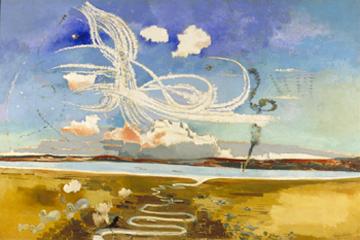 Oil on canvas 121.9 x 182.8 cmThe painting is an attempt to give the sense of an aerial battle in operation over a wide area and thus summarises England's great aerial victory over Germany. The scene includes certain elements constant during the Battle of Britain - the river winding from the town and across parched country, down to the sea; beyond, the shores of the Continent, above, the mounting cumulus concentrating at sunset after a hot brilliant day; across the spaces of sky, trails of airplanes, smoke tracks of dead or damaged machines falling, floating clouds, parachutes, balloons. Against the approaching twilight new formations of Luftwaffe, threatening.
Oil on canvas 121.9 x 182.8 cmThe painting is an attempt to give the sense of an aerial battle in operation over a wide area and thus summarises England's great aerial victory over Germany. The scene includes certain elements constant during the Battle of Britain - the river winding from the town and across parched country, down to the sea; beyond, the shores of the Continent, above, the mounting cumulus concentrating at sunset after a hot brilliant day; across the spaces of sky, trails of airplanes, smoke tracks of dead or damaged machines falling, floating clouds, parachutes, balloons. Against the approaching twilight new formations of Luftwaffe, threatening.Eric Ravilious (1903-1942)
HMS Ark Royal in action, painted on board HMS Highlander near Norway, 1940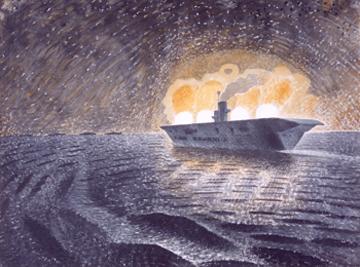 Watercolour on paper 42.5 x 57.7 cmRavilious's description of HMS Ark Royal firing its guns is not just a wonderful piece of design that plays with the light and sound of fireworks; it also captures the frozen terror of the awesome firepower of the weaponry. This has a sublime beauty, not just because of the ship's frightening strength, but because the brightness of the explosion temporarily conceals the precarious position of the crew utterly dependent on the metal boat for their lives at sea.
Watercolour on paper 42.5 x 57.7 cmRavilious's description of HMS Ark Royal firing its guns is not just a wonderful piece of design that plays with the light and sound of fireworks; it also captures the frozen terror of the awesome firepower of the weaponry. This has a sublime beauty, not just because of the ship's frightening strength, but because the brightness of the explosion temporarily conceals the precarious position of the crew utterly dependent on the metal boat for their lives at sea.Miller Brittain
Night Target, Germany, 1946 Oil and tempera on Masonite, 76.5 x 61 cmA bomb aimer with the Royal Canadian Air Force during the Second World War, Miller Brittain flew 34 missions and was awarded the Distinguished Flying Cross.
Oil and tempera on Masonite, 76.5 x 61 cmA bomb aimer with the Royal Canadian Air Force during the Second World War, Miller Brittain flew 34 missions and was awarded the Distinguished Flying Cross.
"A German city under bombing often looked like a casket of jewels opening up."
Brittain wrote to his parents in 1944: "The night attacks although they are deadly are very beautiful from our point of view. The target is like an enormous lighted Christmas tree twenty miles away but straight beneath one looks like pictures I have seen of the mouth of hell." In a 1946 letter to his parents he assessed this painting critically: "My target picture looks like the real thing they say, but I don't like it yet as a picture. In fact at the moment, I feel like putting my foot though it."Charles Comfort (1900-1994)
Night air raid, 1944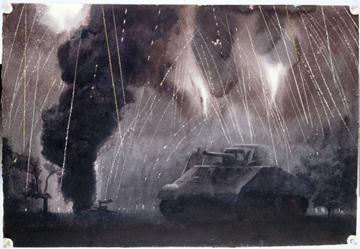 Watercolour on paper 36.6 x 53.8 cmOn the back of the painting Comfort noted: "This raid occurred at 0345 hrs. 22 May 44. We were awakened by the intensely heavy ack ack fire to find the area lit by magnesium parachute flares, and crossed and arched by thousands of Oerlikon Tracer bullets. The bombing occurred forward of Div. H.Q., but we stayed respectfully in our slit trenches until it was over."Wrecked Me210, 1944
Watercolour on paper 36.6 x 53.8 cmOn the back of the painting Comfort noted: "This raid occurred at 0345 hrs. 22 May 44. We were awakened by the intensely heavy ack ack fire to find the area lit by magnesium parachute flares, and crossed and arched by thousands of Oerlikon Tracer bullets. The bombing occurred forward of Div. H.Q., but we stayed respectfully in our slit trenches until it was over."Wrecked Me210, 1944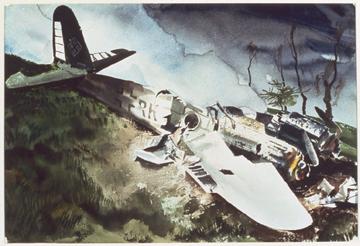 Oil on canvas 35.5 x 51.7 cmWritten on the back: "This enemy plane crashed at 0728 hrs today [15 April 1944]. This note is being made before an official sitrep is available. Equal claims are being made by 2 LAA, RCA, and an unknown South African Spitfire pilot. After inspecting the wreckage and hearing evidence, I must say, I credit the plane to the S.A. boy. The fumes from the fire smelled strongly of carbide and a whitish ash covered the wreckage. The fuselage rests, and points at an angle of 40°, down into the MORO valley. The most significant thing about this plane was that in the centre of the white cross, to the left of the letters RK there is written in pencil, smoked over, 'Allons enfants de la patrie, le jour de gloire est arrivé'." Some historians contend that this aircraft is actually a Messerschmitt 410 twin-engined fighter bomber.
Oil on canvas 35.5 x 51.7 cmWritten on the back: "This enemy plane crashed at 0728 hrs today [15 April 1944]. This note is being made before an official sitrep is available. Equal claims are being made by 2 LAA, RCA, and an unknown South African Spitfire pilot. After inspecting the wreckage and hearing evidence, I must say, I credit the plane to the S.A. boy. The fumes from the fire smelled strongly of carbide and a whitish ash covered the wreckage. The fuselage rests, and points at an angle of 40°, down into the MORO valley. The most significant thing about this plane was that in the centre of the white cross, to the left of the letters RK there is written in pencil, smoked over, 'Allons enfants de la patrie, le jour de gloire est arrivé'." Some historians contend that this aircraft is actually a Messerschmitt 410 twin-engined fighter bomber.Eric Thake (1904-1982)
Wrecked Lodestar, 1945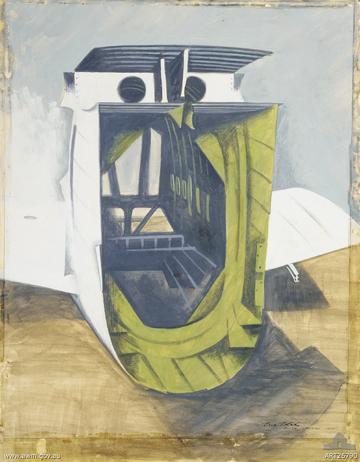 Gouache, pencil on paper 50.4 x 39.2 cmThake was interested in the technology of war and its aftermath, particularly crashed and abandoned aircraft, bombed buildings and deserted camps. Surrealism was the means by which he could explore these themes in his art. A graphic artist by training, he was able to simplify the forms of the machines; his aircraft, as here for example, have turned into desiccated insects sitting derelict in the landscape, their interiors exposed to the elements.
Gouache, pencil on paper 50.4 x 39.2 cmThake was interested in the technology of war and its aftermath, particularly crashed and abandoned aircraft, bombed buildings and deserted camps. Surrealism was the means by which he could explore these themes in his art. A graphic artist by training, he was able to simplify the forms of the machines; his aircraft, as here for example, have turned into desiccated insects sitting derelict in the landscape, their interiors exposed to the elements.Cedric Kennedy (1898-1968)
A camouflaged runway, c. 1944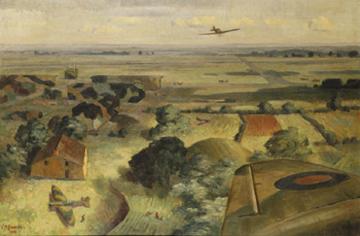 Oil on canvas 49.5 x 74.9 cmKennedy was best known as a landscape painter, but he was also a pilot, and this painting combines both passions as he explores the complex patterns of the camouflaged buildings and their relationship to the landscape. (The painting was a break from the despondent monochrome images Kennedy was making at the time.) The nation might be at war, but around the airfield, country life, with all the values so closely associated with British identity, continues.
Oil on canvas 49.5 x 74.9 cmKennedy was best known as a landscape painter, but he was also a pilot, and this painting combines both passions as he explores the complex patterns of the camouflaged buildings and their relationship to the landscape. (The painting was a break from the despondent monochrome images Kennedy was making at the time.) The nation might be at war, but around the airfield, country life, with all the values so closely associated with British identity, continues.Alan Sorrell (1904-1974)
Construction of a runway at an aerodrome, 1946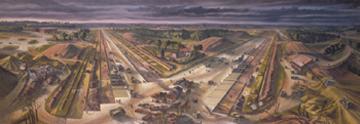 Oil on canvas 66 x 187.9 cmThe scale, shape and detail of the Sorrell's painting give some indication of the work required to construct the many runways required to defend Britain and to launch attacks on Germany. The runway dominates the landscape, slicing through and side-lining the old agricultural order. This is clearly the future, the run-down farmhouse part of the past.MORE ...
Oil on canvas 66 x 187.9 cmThe scale, shape and detail of the Sorrell's painting give some indication of the work required to construct the many runways required to defend Britain and to launch attacks on Germany. The runway dominates the landscape, slicing through and side-lining the old agricultural order. This is clearly the future, the run-down farmhouse part of the past.MORE ...
www.warmuseum.ca

